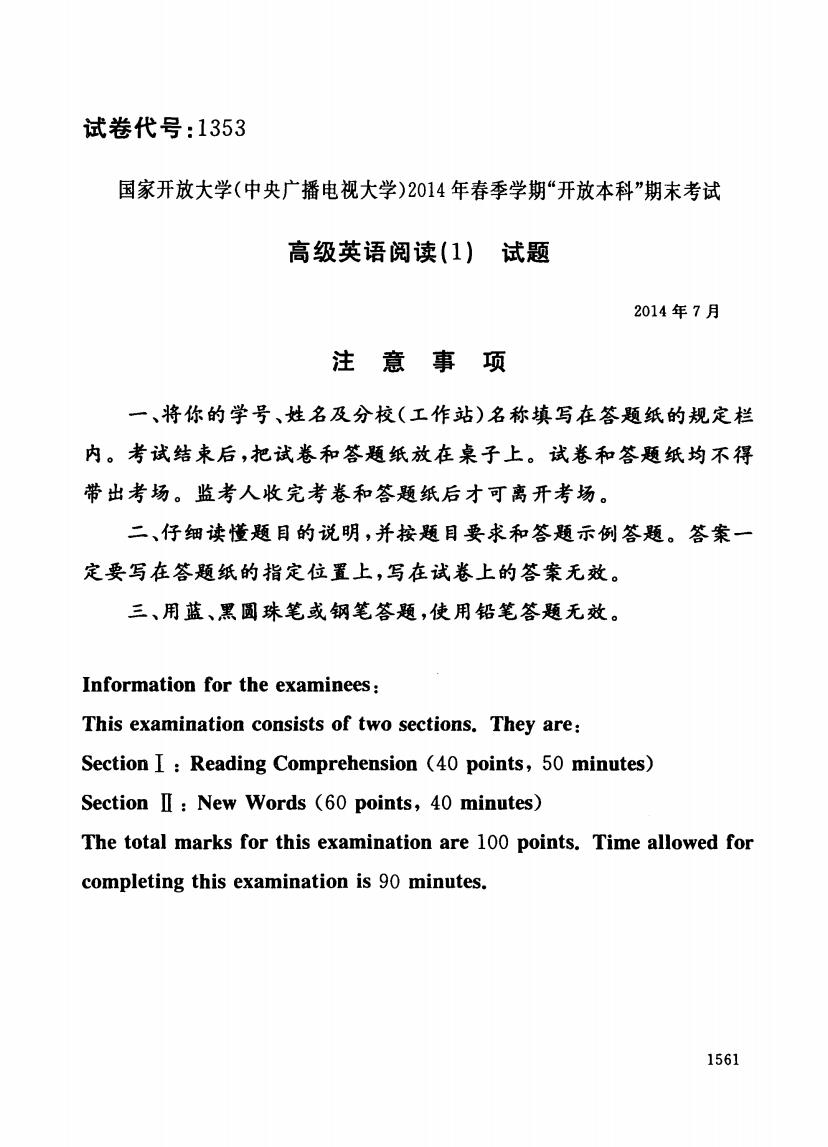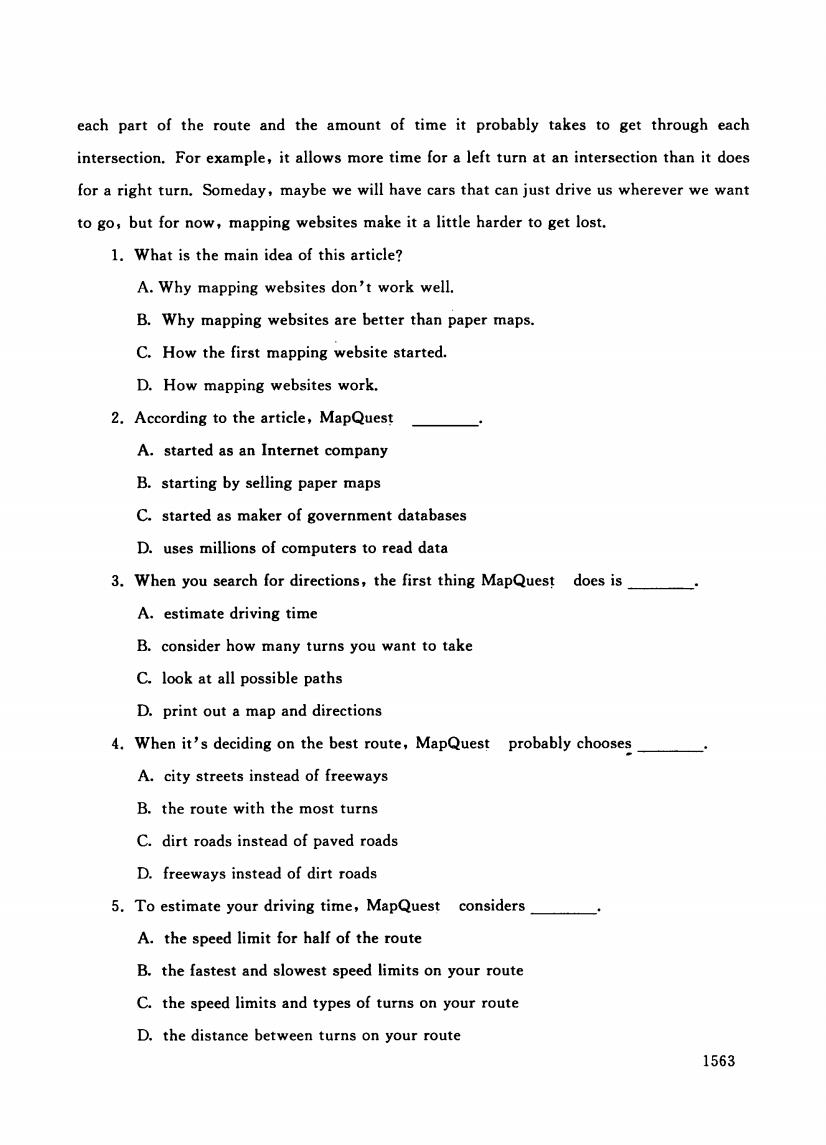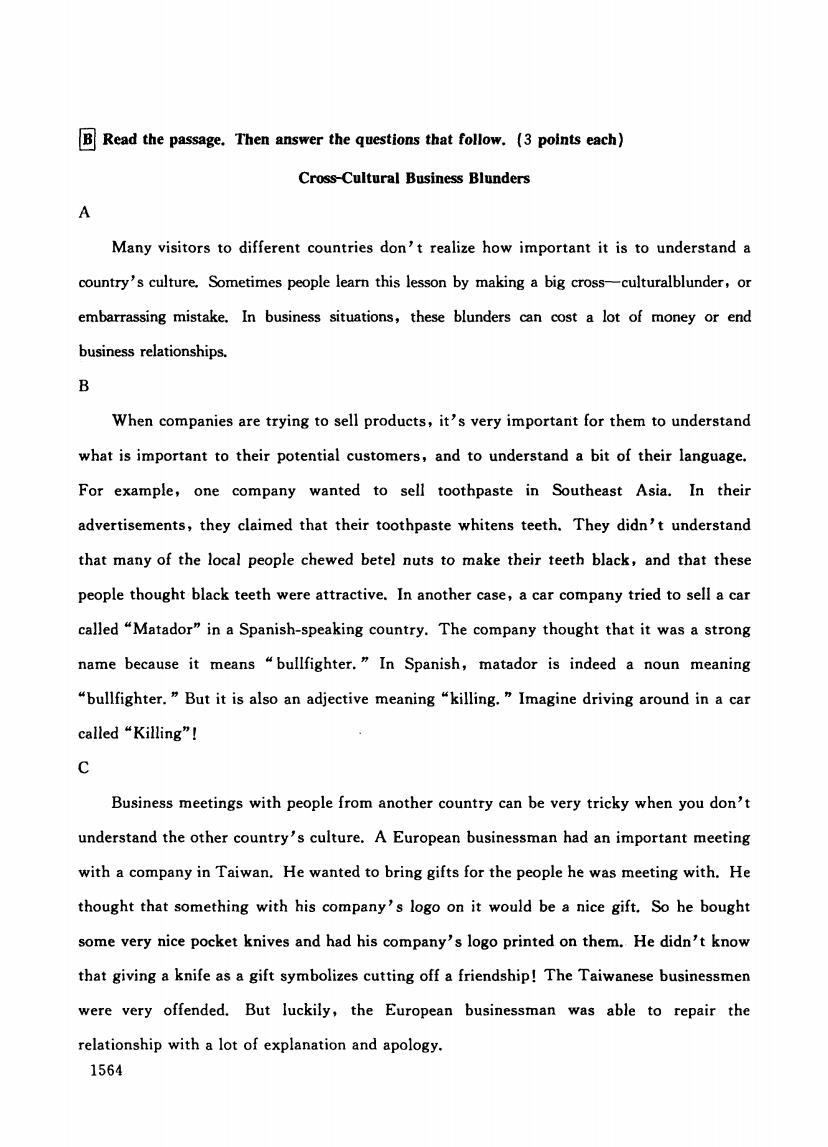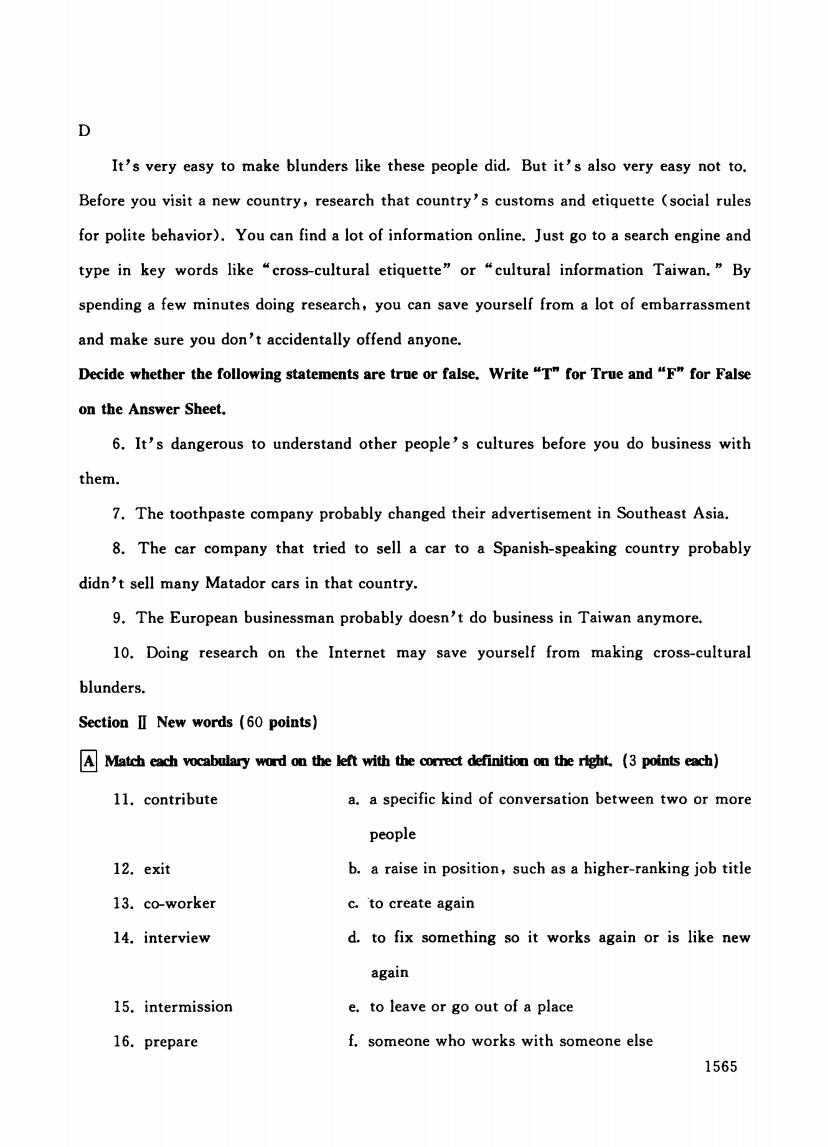
试卷代号:1353 国家开放大学(中央广播电视大学)2014年春季学期“开放本科”期末考试 高级英语阅读(1)试题 2014年7月 注意事项 一、将你的学号、姓名及分校(工作站)名称填写在答题纸的规定栏 内。考试结束后,把试卷和答题纸放在桌子上。试卷和答题纸均不得 带出考场。监考人收完考卷和答题纸后才可离开考场。 二、仔细读懂题目的说明,并按题目要求和答题示例答题。答案一 定要写在答题纸的指定位置上,写在试卷上的答案无效。 三、用蓝、黑圆珠笔或钢笔答题,使用铅笔答题无效。 Information for the examinees: This examination consists of two sections.They are: Section I Reading Comprehension (40 points,50 minutes) SectionⅡ:New Words(60 points,40 minutes) The total marks for this examination are 100 points.Time allowed for completing this examination is 90 minutes. 1561
试卷代号 3 5 3 国家开放大学(中央广播电视大学 4年春季学期"开放本科"期末考试 高级英语阅读( 1) 2014 年7 注意事项 一、将你的学号、姓名及分校(工作站)名称填写在答题纸的规定栏 内。考试结束后,把试卷和答题纸放在桌子上。试卷和答题纸均不得 带出考场。监考人收完考卷和答题纸后才可离开考场。 二、仔细读懂题目的说明,并按题目要求和答题示例答题。答案一 定要写在答题纸的指定位置上,写在试卷上的答案元效。 三、用蓝、黑圆珠笔或钢笔答题,使用铅笔答题元效。 Information for the examinees: This examination consists of two sections. They are: Section I : Reading Comprehension (40 points, 50 minutes) Section II : New Words (60 points, 40 minutes) The total marks for this examination are 100 points. Time allowed for completing this examination is 90 minutes. 1561

Interactions Reading I Section I Reading Comprehension (40 points) 囚 Read the passage.Then answer the questions that follow.(5 points each) Mapping Websites:How Do They Work? A These days,it's getting easier and easier to find your way around.Some people have GPS devices in their cars to make sure they don't get lost.GPS stands for Global Positioning System.These devices use satellites in space to "see"where you are and give you directions to where you want to go.And if you don't have a GPS device,you can simply go online to get step-by-step directions.Websites like MapQuest.com and mappoint.msn.com can produce a map and directions in just a few seconds.But how do they do it? B MapQuest uses data (information)from a few different sources to produce directions and maps.Before MapQuest went online,it sold regular paper maps in places like gas stations.The website uses the data from those paper maps,information from digital mapping companies,and government databases.At the moment,MapQuest uses more than 30 computers to read all this data and provides users with millions of maps every day. C In order to find the best route (way or path)from one place to another,MapQuest first has to look at all possible routes.Then MapQuest looks at each part of each possible route.It considers the types of roads on the different routes.Are they dirt roads,paved roads,freeways,or city streets?It looks at how many turns there are in each route and what kinds of turns they are.Are they right turns or left turns?It also considers the speed limit on each road and how many intersections there are.An interSection is "a place where two or more roads cross each other. D MapQuest can also tell you how long your trip will take you.It does this by doing some math.MapQuest bases its estimated driving times on the length and speed limit of 1562
Interactions Reading I Section I Reading Comprehension (40 points) Read the passage. Then answer the questions that follow. (5 points 四ch) Mapping Websit How Do They Work? A These days, it' s getting easier and easier to find your way around. Some people have GPS devices in their cars to make sure they don't get lost. GPS stands for Global Positioning System. These devices use satellites in space to "see" where you are and give you directions to where you want to go. And if you don't have a GPS device , you can simply go online to get step-by-step directions. Websites like MapQuest. com and mappoint. msn. com can produce a map and directions in just a few seconds. But how do they do it? B MapQuest uses data (information) from a few different sources to produce directions and maps. Before MapQuest went online , it sold regular paper maps in places like gas stations. The website uses the data from those paper maps, information from digital mapping companies, and government databases. At the moment , MapQuest uses more than 30 computers to read all this data and provides users with millions of maps every day. C In order to find the best route (way or path) from one place to another, MapQuest first has to look at all possible routes. Then MapQuest looks at each part of each possible route. It considers the types of roads on the different routes. Are they dirt roads, paved roads, freeways, or city streets? It looks at how many turns there are in each route and what kinds of turns they are. Are they right turns or left turns? It also considers the speed limit on each road and how many intersections there are. An interSection is "a place where two or more roads cross each other. " D MapQuest can also tell you how long your trip will take you. It does this by doing some math. MapQuest bases its estimated driving times on the length and speed limit of 1562

each part of the route and the amount of time it probably takes to get through each intersection.For example,it allows more time for a left turn at an intersection than it does for a right turn.Someday,maybe we will have cars that can just drive us wherever we want to go,but for now,mapping websites make it a little harder to get lost. 1.What is the main idea of this article? A.Why mapping websites don't work well. B.Why mapping websites are better than paper maps. C.How the first mapping website started. D.How mapping websites work. 2.According to the article,MapQuest A.started as an Internet company B.starting by selling paper maps C.started as maker of government databases D.uses millions of computers to read data 3.When you search for directions,the first thing MapQuest does is A.estimate driving time B.consider how many turns you want to take C.look at all possible paths D.print out a map and directions 4.When it's deciding on the best route,MapQuest probably chooses A.city streets instead of freeways B.the route with the most turns C.dirt roads instead of paved roads D.freeways instead of dirt roads 5.To estimate your driving time,MapQuest considers A.the speed limit for half of the route B.the fastest and slowest speed limits on your route C.the speed limits and types of turns on your route D.the distance between turns on your route 1563
each part of the route and the amount of time it probably takes to get through each intersection. For example. it allows more time for a left turn at an intersection than it does for a right turn. Someday. maybe we will have cars that can just drive us wherever we want to go. but for now. mapping websites make it a little harder to get lost. 1. What is the main idea of this article? A. Why mapping websites don't work well. B. Why mapping websites are better than paper maps. C. How the first mapping website started. D. How mapping websites work. 2. According to the article. MapQues~ A. started as an Internet company B. starting by selling paper maps C. started as maker of government databases D. uses millions of computers to read data 3. When you search for directions. the first thing MapQues~ does is A. estimate driving time B. consider how many turns you want to take C. look at all possible paths D. print out a map and directions 4. When it's deciding on the best route. MapQuest probably chooses A. city streets instead of freeways B. the route with the most turns C. dirt roads instead of paved roads D. freeways instead of dirt roads 5. To estimate your driving time. MapQuest considers A. the speed limit for half of the route B. the fastest and slowest speed limits on your route C. the speed limits and types of turns on your route D. the distance between turns on your route 1563

BRead the passage.Then answer the questions that follow.(3 points each) Cross-Cultural Business Blunders A Many visitors to different countries don't realize how important it is to understand a country's culture.Sometimes people learn this lesson by making a big cross-culturalblunder,or embarrassing mistake.In business situations,these blunders can cost a lot of money or end business relationships. B When companies are trying to sell products,it's very important for them to understand what is important to their potential customers,and to understand a bit of their language. For example,one company wanted to sell toothpaste in Southeast Asia.In their advertisements,they claimed that their toothpaste whitens teeth.They didn't understand that many of the local people chewed betel nuts to make their teeth black,and that these people thought black teeth were attractive.In another case,a car company tried to sell a car called "Matador"in a Spanish-speaking country.The company thought that it was a strong name because it means "bullfighter.In Spanish,matador is indeed a noun meaning “bullfighter..”But it is also an adjective meaning“killing.”Imagine driving around in a car called“Killing”I Q Business meetings with people from another country can be very tricky when you don't understand the other country's culture.A European businessman had an important meeting with a company in Taiwan.He wanted to bring gifts for the people he was meeting with.He thought that something with his company's logo on it would be a nice gift.So he bought some very nice pocket knives and had his company's logo printed on them.He didn't know that giving a knife as a gift symbolizes cutting off a friendship!The Taiwanese businessmen were very offended.But luckily,the European businessman was able to repair the relationship with a lot of explanation and apology. 1564
the passage. Then answer the questions 由at follow. (3 poi 回ch) Cr 伊Cultural 皿in臼s Blunders A Many visitors to different countries don' t realize how important it is to understand a un ry s culture. Sometimes pωpIe learn this lesson by making a big cross-culturalblunder. or embarrassing mistake. In business situations, these blunders can ∞st a lot of money or end business relationships. B When companies are trying to sell products. it's very important for them to understand what is important to their potential customers. and to understand a bit of their language. For example , one company wanted to sell toothpaste in Southeast Asia. In their advertisements, they claimed that their toothpaste whitens teeth. They didn' t understand that many of the local people chewed betel nuts to make their teeth black. and that these people thought black teeth were attractive. In another case. a car company tried to sell a car called "Matador" in a Spanish-speaking country. The company thought that it was a strong name because it means "bullfighter." In Spanish. matador is indeed a noun meaning "bullfighter. " But it is also an adjective meaning "killing. " Imagine driving around in a car called "Killing"! C Business meetings with people from another country can be very tricky when you don't understand the other country's culture. A European businessman had an important meeting with a company in Taiwan. He wanted to bring gifts for the people he was meeting with. He thought that something with his company' s logo on it would be a nice gift. SO he bought some very nice pocket knives and had his company's logo printed on them. He didn't know that giving a knife as a gift symbolizes cutting off a friendship! The Taiwanese businessmen were very offended. But luckily. the European businessman was able to repair the relationship with a lot of explanation and apology. 1564

D It's very easy to make blunders like these people did.But it's also very easy not to. Before you visit a new country,research that country's customs and etiquette (social rules for polite behavior).You can find a lot of information online.Just go to a search engine and type in key words like“cross-cultural etiquette”or“cultural information Taiwan.”By spending a few minutes doing research,you can save yourself from a lot of embarrassment and make sure you don't accidentally offend anyone. Decide whether the following statements are true or false.Write "T"for True and "F"for False on the Answer Sheet. 6.It's dangerous to understand other people's cultures before you do business with them. 7.The toothpaste company probably changed their advertisement in Southeast Asia. 8.The car company that tried to sell a car to a Spanish-speaking country probably didn't sell many Matador cars in that country. 9.The European businessman probably doesn't do business in Taiwan anymore. 10.Doing research on the Internet may save yourself from making cross-cultural blunders. Section II New words (60 points) A Match each vocabulary word on the left with the correct definition on the right.(3 points each) 11.contribute a.a specific kind of conversation between two or more people 12.exit b.a raise in position,such as a higher-ranking job title 13.co-worker c.to create again 14.interview d.to fix something so it works again or is like new again 15.intermission e.to leave or go out of a place 16.prepare f.someone who works with someone else 1565
D It's very easy to make bl unders like these people did. But it' s also very easy not to. Before you visit a new country , research that country' s customs and etiquette (social rules for polite behavior). You can find a lot of information online. ] ust go to a search engine and type in key words like "cross-cultural etiquette" or "cultural information Taiwan." By spending a few minutes doing research , you can save yourself from a lot of embarrassment and make sure you don' t accidentally offend anyone. 配ide whether the following statements are true or false. Write "T" for True and "F" for False on the Answer Sheet. 6. It's dangerous to understand other people' s cultures before you do business with them. 7. The toothpaste company probably changed their advertisement in Southeast Asia. 8. The car company that tried to sell a car to a Spanish-speaking country probably didn't sell many Matador cars in that country. 9. The European businessman probably doesn't do business in Taiwan anymore. 10. Doing research on the Internet may save yourself from making cross-cultural blunders. Section II New words (60 points) 囚脑蛐础WCabUI町叫佣伽峭咐伽m回创皿阳锢伽峭t. (3 11. contribute 12. exit 13. co-worker 14. interview 15. intermission 16. prepare a. a specific kind of conversation between two or more people b. a raise in position , such as a higher-ranking job title c. to create agam d. to fix something so it works again or is like new agam e. to leave or go out of a place f. someone who works with someone else 1565